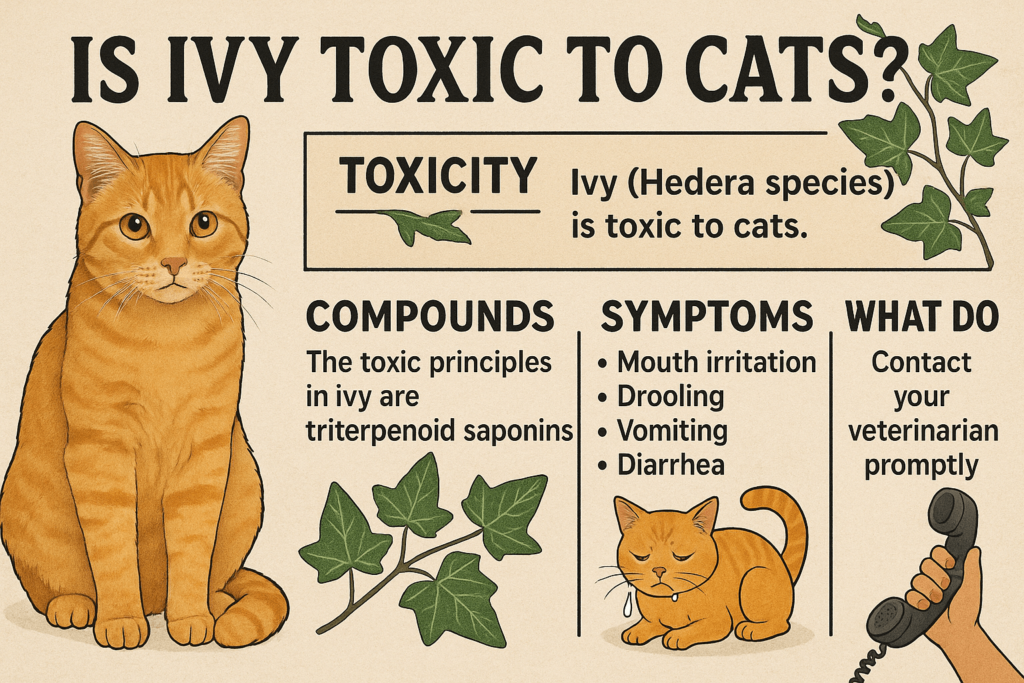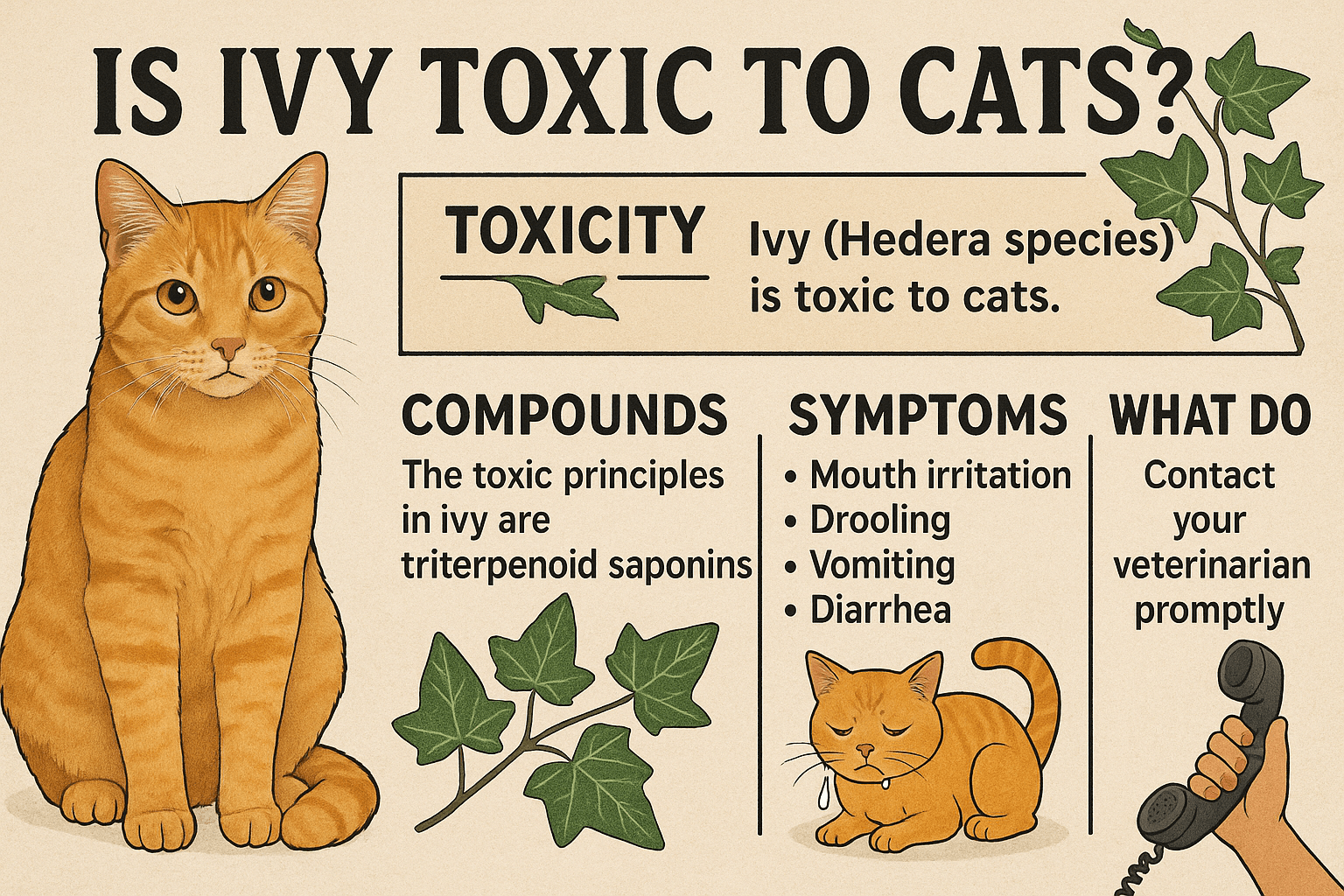Is Ivy Toxic to Cats?
Houseplants and garden greenery can bring life and beauty to your home, but not all plants are safe for our feline companions. Ivy, a popular decorative plant known for its lush foliage, often raises concerns among cat owners about its potential toxicity. While some varieties of ivy are harmless, others can pose serious health risks if ingested by curious cats. Understanding which types of ivy are dangerous, recognizing the symptoms of poisoning, and learning how to keep your pet safe are essential steps in ensuring their well-being. Let’s explore everything you need to know about ivy and its effects on cats.
Expert Opinion on Ivy Toxicity
“It is important to keep in mind that there are many plants labeled as ‘ivy’ that are not true ivy, and that’s where some confusion sets in. When discussing the dangers that ivy can pose to cats, the American Society for the Prevention and Cruelty of Animals (ASPCA) database lists several plant species under the term ‘ivy’, as toxic.”
Types of Ivy and Their Toxicity Levels
Not all ivy plants are created equal when it comes to safety for cats. Some varieties contain toxic compounds that can harm your feline friend, while others are non-toxic and pose little risk. Here’s a breakdown of common ivy types and their potential dangers.
English Ivy (Hedera helix):
English ivy is one of the most toxic varieties, containing saponins that can irritate a cat’s digestive system and skin.Algerian Ivy (Hedera canariensis):
Similar to English ivy, Algerian ivy also contains harmful saponins and should be avoided in homes with pets.Boston Ivy (Parthenocissus tricuspidata):
Despite its name, Boston ivy is not a true ivy and is considered non-toxic to cats, making it a safer choice for pet-friendly spaces.Swedish Ivy (Plectranthus verticillatus):
Swedish ivy is another non-toxic variety, but it’s still best to monitor your cat to prevent overconsumption, which can cause mild stomach upset.Variegated Ivy (Hedera spp.):
Variegated ivy, like other true ivies, contains toxins that can lead to drooling, vomiting, and diarrhea if ingested by cats.
Knowing which types of ivy to avoid helps you create a safer environment for your furry companion.

Symptoms of Ivy Poisoning in Cats
If your cat has ingested toxic ivy, they may exhibit a range of symptoms depending on the amount consumed and the specific variety. Recognizing these signs early can help you seek prompt veterinary care.
Excessive Drooling:
One of the first signs of ivy poisoning is excessive salivation, caused by irritation of the mouth and throat.Vomiting and Diarrhea:
Gastrointestinal upset is common after ingestion, leading to vomiting and loose stools as the body tries to expel the toxins.Difficulty Swallowing:
Swelling or irritation in the throat may make it difficult for your cat to swallow food or water.Skin Irritation:
Contact with certain ivy leaves can cause redness, itching, or rashes on your cat’s skin.Lethargy and Weakness:
In severe cases, your cat may appear unusually tired or weak, indicating systemic effects from the toxins.
Promptly addressing these symptoms ensures your cat receives the care they need to recover fully.
Check this guide 👉Tall Indoor Plants Safe for Cats: Best 7 Expert Tips!
Check this guide 👉Is Gladiolus Cat Safe? Best 7 Expert Tips!
Check this guide 👉Is Anthurium Safe for Cats? Best 7 Expert Tips!
Toxic Ivy Varieties | Non-Toxic Ivy Alternatives |
|---|---|
English Ivy (Hedera helix) | Boston Ivy (Parthenocissus tricuspidata) |
Algerian Ivy (Hedera canariensis) | Swedish Ivy (Plectranthus verticillatus) |
Variegated Ivy (Hedera spp.) | Spider Plant (Chlorophytum comosum) |
Ground Ivy (Glechoma hederacea) | Parlor Palm (Chamaedorea elegans) |
Persian Ivy (Hedera colchica) | African Violet (Saintpaulia spp.) |
How to Keep Your Cat Safe Around Ivy
Preventing exposure to toxic ivy is key to protecting your cat’s health. These practical tips can help you minimize risks and create a pet-safe environment.
Identify Plants in Your Home:
Inspect all houseplants and garden greenery to ensure none are toxic to cats. Remove or replace harmful varieties immediately.Place Plants Out of Reach:
If you choose to keep ivy indoors, position it on high shelves or hanging planters where your cat cannot access it.Use Pet-Safe Deterrents:
Apply natural deterrent sprays or citrus scents around plants to discourage your cat from approaching them.Supervise Outdoor Time:
Monitor your cat closely during outdoor playtime to prevent them from chewing on unfamiliar plants.Educate Family Members:
Ensure everyone in your household understands the risks of toxic plants and knows how to respond if an incident occurs.
Taking these precautions reduces the likelihood of accidental ingestion and keeps your cat safe.
Steps to Take If Your Cat Eats Ivy
If you suspect your cat has ingested toxic ivy, acting quickly is crucial for their recovery. Follow these steps to address the situation effectively.
Remove Any Remaining Plant Material:
Gently check your cat’s mouth and remove any visible pieces of ivy to prevent further ingestion.Rinse Their Mouth:
Use clean water to rinse your cat’s mouth and reduce irritation from sap or residue.Call Your Veterinarian:
Contact your vet immediately for advice on whether your cat needs emergency treatment.Monitor Symptoms Closely:
Keep a close eye on your cat’s behavior and note any changes to report to the vet.Do Not Induce Vomiting Without Guidance:
Attempting to induce vomiting at home can worsen the situation—always consult a professional first.
Quick action and professional guidance are essential for managing suspected ivy poisoning.
Signs Your Cat Has Been Exposed to Toxic Plants
Even if you’re unsure whether your cat has eaten ivy, certain behaviors can indicate exposure to toxic plants. Being aware of these signs allows you to act quickly and protect your pet.
Increased Thirst or Urination:
Some toxins can affect kidney function, leading to changes in drinking and urination patterns.Pawing at the Mouth:
Cats may paw at their face or mouth if they experience irritation from plant sap.Loss of Appetite:
Refusal to eat could signal gastrointestinal distress caused by plant ingestion.Unusual Vocalization:
Cats in pain or discomfort may vocalize more frequently than usual.Behavioral Changes:
Lethargy, hiding, or aggression can indicate your cat is feeling unwell due to plant exposure.
Recognizing these signs helps you intervene promptly and seek veterinary assistance if needed.
How to Make Your Garden Cat-Friendly
If you have an outdoor space, creating a cat-friendly garden ensures your pet can explore safely without encountering harmful plants.
Choose Non-Toxic Plants:
Opt for pet-safe options like lavender, marigolds, and snapdragons to decorate your garden.Install Barriers Around Hazardous Areas:
Use fencing or netting to block access to areas with toxic plants or chemicals.Provide Shade and Shelter:
Include cozy spots under trees or shrubs where your cat can rest comfortably outdoors.Avoid Chemical Pesticides:
Use natural pest control methods to eliminate harmful substances from your garden.Encourage Natural Behaviors:
Incorporate scratching posts or climbing structures to engage your cat’s instincts.
A thoughtfully designed garden allows your cat to enjoy the outdoors safely.
Benefits of Choosing Pet-Safe Plants
Switching to pet-safe plants not only protects your cat but also enhances your living space in meaningful ways.
Peace of Mind:
Knowing your plants are safe eliminates worry about accidental ingestion or poisoning.Improved Air Quality:
Many pet-safe plants, such as spider plants and peace lilies, naturally purify indoor air.Enhanced Bonding Opportunities:
Sharing a safe, green environment fosters trust and strengthens your relationship with your cat.Creative Decor Options:
Pet-safe plants come in a variety of shapes, sizes, and colors, allowing for stylish arrangements.Support for Multi-Pet Households:
Choosing safe plants benefits all pets, including dogs and small animals, creating a harmonious home.
By prioritizing pet safety, you create a vibrant, welcoming space for everyone to enjoy.
Frequently Asked Questions About Ivy and Cats
What should I do if my cat eats ivy?
Contact your veterinarian immediately and monitor your cat for symptoms like vomiting, drooling, or lethargy.
Are all ivy plants toxic to cats?
No, some varieties like Boston ivy and Swedish ivy are non-toxic, but many true ivy species contain harmful compounds.
Can ivy cause long-term damage to cats?
Ingestion typically causes short-term symptoms, but severe cases may require medical intervention to prevent complications.
How can I tell if my ivy is toxic?
Research the specific variety or consult a plant expert to determine its toxicity level before bringing it into your home.
What are some cat-safe plants I can grow instead?
Spider plants, parlor palms, and African violets are excellent pet-friendly alternatives to ivy.
Creating a Safe Space for Your Feline Friend
While ivy adds charm and elegance to homes and gardens, its potential toxicity to cats makes it a risky choice for pet owners. By identifying hazardous varieties, recognizing symptoms of poisoning, and taking proactive measures to safeguard your pet, you can enjoy greenery without compromising your cat’s health. Remember, prevention is always better than cure—choosing pet-safe plants and supervising your cat’s interactions with greenery ensures a harmonious and worry-free environment. With care and attention, you can nurture both your love for plants and your bond with your feline companion.
Canned Pumpkin for Cat Diarrhea: Best 7 Expert Tips! Natural remedy to firm stools, soothe upset bellies, and support gut health safely.
Can a Cat Give You Scabies? Best 7 Expert Tips! Discover the truth about feline mites, human skin risks, and how to protect yourself—without panic.
Cat Flea vs Human Flea: Best 7 Expert Tips! Discover the truth about bites, species, and how to eliminate infestations for good.
Weird Cat Behaviors: Best 7 Expert Tips! Discover why cats do strange things—and how to understand, not punish, their instincts for a happier home.





